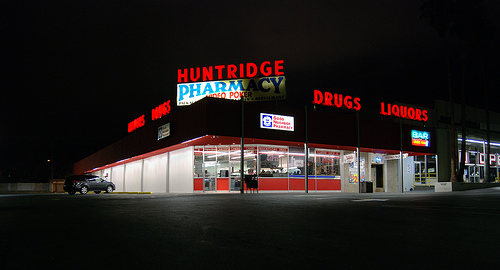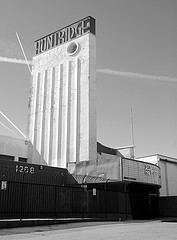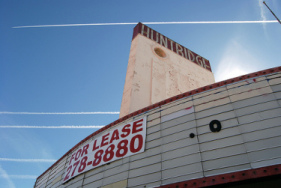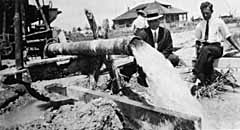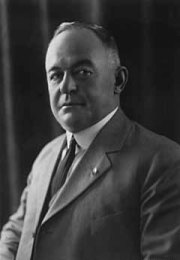I was reading the paperwork for the nomination of the Huntridge Theater to be designated a place on the National Registry of Historic Places. It makes for interesting reading. The nomination is dated Feb. 22nd, 1993. You can read in its entirety here.
Reading, I was reminded of the circular driveway that used to be there in front of the theater. I had long forgotten about it but the minute I read about it, I saw it clearly in mind as if it were yesterday. I remember standing in lines that used to snake down to Charleston Blvd and then turn east for the blockbuster movies.
I vividly remember the old Post Office, the Huntridge Station, that was next door (in what used to be Cima Mattress) but have no recollection of a bank. The Restaurant Supply Store on the east side of the property used to be Oran Gragson Furniture. I remember my mom shopping for furniture there when Oran Gragson was also the mayor.
As you approached, the ticket booth was to the right of the entrance, though I also vaguely recall it having its own ticket booth when I was quite young. But my memory may be playing tricks on me there. Once in the lobby, the concession stand was to the right and the big doors leading into the auditorium were to the left. The projection booth (and separate cry room) were accessible by stairs via a door on the other side of the concession area. The auditorium seated 1000 people (but since this report was filed, the interior has all been gutted).
Also according to the nomination, the neon signage used to be in script. The theater interior had been halved sometime in the early 1980s but by the time that the Friends of the Huntridge had entered the picture, they had taken down the dividing wall and turned the auditorium back into a large facility.
The Original murals were painted over long ago as were the ones in the adjoining Post Office.
Despite those changes to the building, the nomination made the case for the building, noting that much of the architectural features that were part of the original building were still there.
Of all the movie theaters of my youth, the Huntridge is the last one standing. The El Portal was long ago refurbished (and the signage and marquee altered) into a gift shop and all the others have been torn down.
The double-bill that opened the Huntridge on October 10th, 1944 were "Hellzapoppin" and "Hi, Neighbor". There was a contest to name the movie stars and the winner received 10 free guest passes and a $25 War Bond. The Huntridge Neighborhood, located behind the theater, provided many of the patrons.
Lloyd and Edythe Katz were granted a 27-year lease on the theater in 1951. Katz was a well-known Southern California theater promoter and he brought with him his numerous studio and star connections. His widow, Edythe told me in a 2005 interview that Lloyd was quite a showman and he knew how to promote. The Huntridge was soon the most popular theater in town. The Katz's were also more liberal than the owner of the El Portal, former mayor Ernie Cragin. The El Portal had a strict segregation policy. The Huntridge, however, was much more open-minded and did not follow a strict policy. In addition to the Huntridge, the Katz's also ran the Fremont Theater (next to the Fremont Hotel) and the Guild Theater both located downtown. The Katz's ran the Huntridge until 1978 when it was purchased by local contractor Frank Silvaggio. The Silvaggio's are a long-time Las Vegas family.
In 1947, Bud Abbott and Lou Costello appeared live on the stage of the Huntridge to promote their movie "Buck Privates Come Home". Judy Garland, Jerry Lewis, Marlene Dietrich and Frank Sinatra all appeared in support of their movies that premiered there. While the "Las Vegas Story" premiered at the Fremont Theater downtown, the crowd was so large that the film also premiered at the Huntridge with Katz "bicycling" the prints between the two theaters.
The theater is a combination of Streamline Moderne and International styles of architecture and the prominent exterior features are still there. The nomination also notes that it is one of the few remaining Las Vegas cultural buildings still standing from the 1940s.
Today, the building is in poor condition and one would never guess of its history and its meaning to the long-timers who whiled many a Saturday afternoon there as children, ushers and parents.
We believe that is vital for everyone who loves Las Vegas history and loves the Huntridge to speak up in support of saving this community treasure. Please leave your comments below. I will be sure that they get heard.
We will be discussing this topic at the Friends of Classic Las Vegas monthly meeting on March 9th. Stay tuned.


